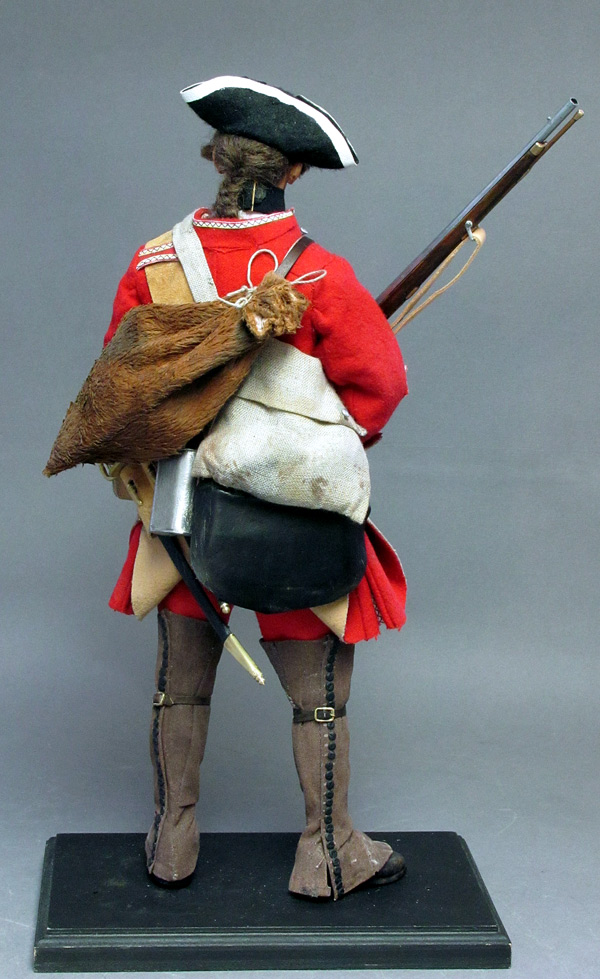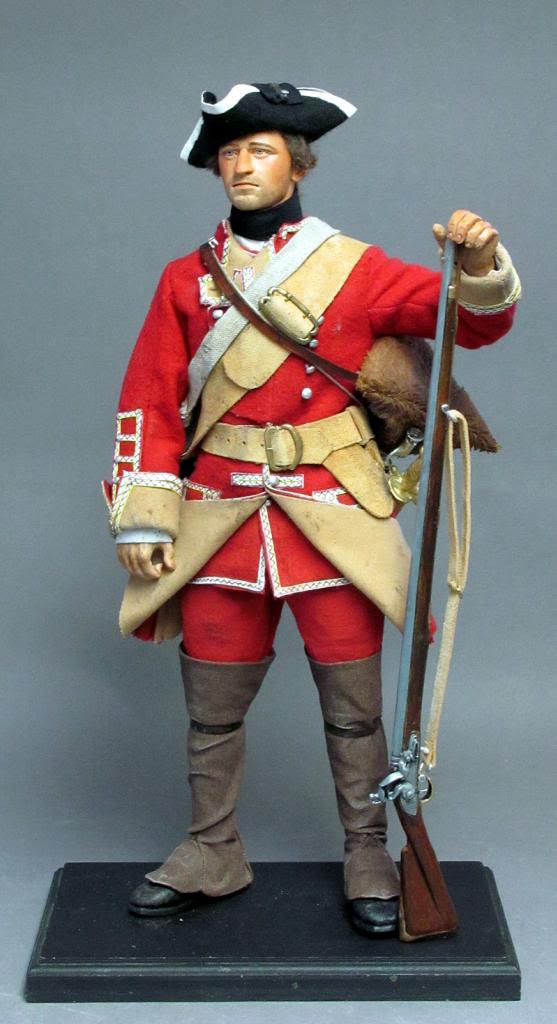Un soldat du 14e Régiment, typique de l'armée britannique durant la rébellion jacobite de 1745-6.
Ce régiment étaient en poste en Flandre contre les Français, lorsque la rébellion a commencé, et ont été renvoyés en Grande-Bretagne, à temps pour la bataille de Falkirk, puis la bataille finale de la rébellion à Culloden en Avril 1746.
Ses vêtements et le matériel est caractéristique de la période.
J'ai eu toutes les boucles en laiton fabriqués spécialement, et l'uniforme est brossé en coton et lin.
Price’s Regiment 1746.The Battle of Culloden, 16 April 1746 , still excites controversy after all this time , especially among Scots worldwide.
It marked the end of sixty years of attempts by the supporters of the Jacobite succession to overthrow the Government in London , and the twilight of the separate, Gaelic tribal culture of the Scottish Highlands .
It was as nasty as any other battle , if mercifully short , but the aftermath has been interpreted by Jacobite sympathisers as a kind of genocide .
But to understand what happened, rather than falling back on the myths of prejudice , I recommend some extensive reading , and the best book on the battle is undoubtedly “ Like Hungry Wolves “ by Stuart Reid, Crowood Press.
It covers the whole war , and gives by far the best analysis that has yet been written.
There are also two Osprey books by Mr.Reid , covering in great detail the two armies engaged , which demolish most of the mythology , particularly about the Jacobite Army .

My figure represents a Private Sentinel of Price’s Regiment , later known as the 14th Foot, and much later still as the Prince of Wales’ Own West Yorkshire Regiment.
It’s based closely on contemporary sources : we have a wonderful series of paintings of all the Foot regiments done by a Swiss artist, David Morier , a couple of years after the battle ( maybe 1748 ) , as well as the rather simpler pics in the Cloathing Book of 1742 .

He’s a hatman , from a centre company , and wears the standard outfit of almost all European soldiers at the time : laced felt hat, long skirted coat worn over a sleeved waistcoat and breeches and gaiters.
The coats were worn closed, with the skirts down at Culloden : the weather was not good. There are also sketches showing soldiers marching with the hats uncocked, with the brims down , but I suspect since the Duke was present on the day there would have been some effort at smartening up.

The outfit is very warm and practical : just as well, because he was provided with nothing else in the way of bedding, and carried not much more than a spare shirt and a nightcap in his goatskin knapsack.
Rations went in the canvas haversack, fluids ( mostly rum or gin ) in the tinplate canteen .He has a sword ( really a former relic of status, soon to be discarded ) and a more useful bayonet .
Except when marching in the field, when tents were sometimes used ,they mostly billeted in inns and houses, so they were not always uncomfortable, though in the aftermath of the war barracks started being built for the first time , particularly in Scotland .

Price’s Regiment ( 304 present all ranks ) stood in the centre of the front line and were not much engaged, since the Jacobites only got to close quarters with the two battalion on the far left front of the Government Army. They fired a couple of volleys as the enemy approached their front.
They had one killed and nine wounded .
 The figure :~
The figure :~Body slightly shortened DML . New head with mohair hair.
Hat of felt, moulded on a block , laced with 1” white tape.
The shirt is linen, the stock black silk with a brass buckle.
Coat , waistcoat and breeches red brushed cotton, lined with buff polysuede and laced with 2mm lacet which has been ( tediously ) painted with red , yellow and black lines : I used pens where possible.
Gaiters painted canvas, pewter buttons.
Shoes ex-DML Napoleonic .
The buff equipment is goatskin .
Goatskin knapsack from fake fur, haversack from linen .

All the brass buckles have been specially made .
I model a pattern , cast it into tin , send it to Birmingham where it’s cast into brass by the lost-wax method. There is about 10% shrinkage .
I’ve had a whole range of mid-18c stuff done, because there are more figures to come….
The sword hilt is done the same way , then fitted with a steel blade.
The musket is my version of the Long Land Pattern : 46” barrel, wooden ramrod .

**********************************************************************************
The Government army , which had a large proportion of Scots in its ranks , had been worsted in the first battles of the war ( Price’s were at Falkirk, where they ran away , the rallied and marched off in good order ), and had a kind of desperate need to vindicate themselves , to get to grips with “ those terrible boasting Highlanders “ . They were given a lot of training in bayonet drill , as much for morale as anything else, and a lot of live firing practice.
It worked.

The Jacobite advance was stopped by continuous, disciplined musketry from a three –deep double line of redcoats and the determined resistance with bayonets of Barrel’s and Munro’s Regiments on the left . The bulk of the Jacobite army never got close enough to cross bayonets….since contrary to the mythology , about 80% of them were armed with muskets rather than swords .

****************************************************************************************************************************************************************************





